1 The Outbreak
The Turks of Greece left few traces. They disappeared suddenly and finally in the spring of 1821 unmourned and unnoticed by the rest of the world. Years later, when travellers asked about the heaps of stones, the old men would explain, ‘There stood the tower of Ali Aga, and there we slew him, his harem, and his slaves’. It was hard to believe then that Greece had once contained a large population of Turkish descent, living in small communities all over the country, prosperous farmers, merchants, and officials, whose families had known no other home for hundreds of years. As the Greeks said, the moon devoured them.
Upwards of twenty thousand Turkish men, women, and children were murdered by their Greek neighbours in a few weeks of slaughter. They were killed deliberately, without qualm or scruple, and there were no regrets either then or later. Turkish families living in single farms or small isolated communities were summarily put to death and their homes burned down over their corpses. Others, when the disturbances began, abandoned home to seek the security of the nearest town, but the defenceless streams of refugees were overwhelmed by bands of armed Greeks.
In the smaller towns, the Turkish communities barricaded their houses and attempted to defend themselves as best they could, but few survived. In some places they were driven by hunger to surrender to their attackers on receiving promises of security, but these were seldom honoured. The men were killed at once and the women and children divided out as slaves, usually to be killed in their turn later. All over the Peloponnese roamed mobs of Greeks armed with clubs, scythes, and a few firearms, killing, plundering, and burning. They were often led by Christian priests, who exhorted them to greater efforts in their holy work.
In the larger towns and in a few fortresses there were garrisons of Turkish and Albanian troops, and they were soon crammed with refugees who had escaped the massacres in the countryside. The troops made occasional sorties to try to break up the bands of Greeks and succeeded in bringing within the safety of the walls the inhabitants of a few Moslem communities, Turkish and Albanian, who had survived the first onslaught. They attempted to terrorize the population back into subjection by summary executions and demonstrations of force, but they could not turn the tide. Within a few weeks of the outbreak of the Revolution, the Turkish and Moslem Albanian population of the Peloponnese, previously about a ninth of the whole, had ceased to exist as a settled community. The towns on the coast which remained in Turkish hands had a precarious life-line to the outside world by sea but the others, including Tripolitsa, the biggest town of the Peloponnese, were under total siege.
During April the inhabitants of the important islands of Hydra, Spetsae, and Psara decided to join the revolutionaries. These islanders, who were mainly Christian Albanians by origin, had built up a strong merchant marine after the French were driven from the Eastern Mediterranean in the Napoleonic period. They armed their ships and began to attack traders flying the Turkish flag. They ranged all over the Aegean and beyond. Many Turkish merchant ships were captured, their crews killed, or thrown overboard, and the booty brought back to port. On several occasions ships crowded with Moslem pilgrims on their way to or from Mecca were seized and the crews and passengers put to death. The capture of a few treasure ships bound for Alexandria brought a rich haul of jewels and precious metals. The crew of a Turkish corvette, fifty-seven men in all, were brought back to Hydra in triumph and individually roasted to death over fires on the beach.
As the forays of the islanders became bolder, the appearance of their warships spread the conflict inexorably to every area where Greeks and Turks had lived together. In Crete it appears that the Turks struck the first blow in an attempt to save themselves, but soon the island was torn with massacres as the two communities tried desperately to overcome one another. In Northern Greece the garrisons were stronger, but in Thessaly, Macedonia, and Chalcidice many Greeks joined the Revolution and mercilessly attacked the Turks. In some areas their leaders deliberately instigated massacres of the Turks in order to try to involve the whole Greek population in the Revolution. Many communities were drawn into the terror against their better judgement. Others remained conspicuously loyal to the Turks or waited to see which way the wind would blow.
At about the same time as these massacres were occurring in Greece, a military revolt took place in the Turkish frontier provinces beyond the Danube, Wallachia and Moldavia, in the area of present-day Romania. Prince Alexander Hypsllantes, a high-ranking Russian officer of Greek descent, crossed the frontier from Russia with a small party of expatriate Greeks. Three local military commanders with whom he had made arrangements beforehand joined him with their troops, but the general rising in the Provinces on which he had staked his chance of success did not occur. The local population, Romanian and Slav, to whom Greeks and Russians were as alien as Turks, were actively hostile, and the only other local forces who joined him were a few bands of undisciplined mercenaries. Hypsilantes issued a proclamation which implied that he was leading an advance party of the Russian army, and that the main force was about to invade European Turkey to liberate the Christian population from the Turks. However, it soon became clear that the Russians had no intention of invading Turkey, and Hypsilantes was officially disowned as a traitor.
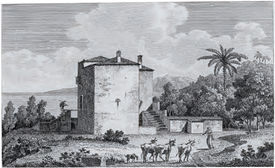
a. A tower belonging to a wealthy Turkish landowner in Peloponnese, surrounded by extensive cultivated fields, plantations, orchards, vineyards, and gardens. One of many ‘the moon devoured’ in 1821.
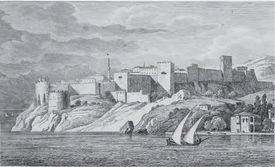
b. The fortress of Coron (Koroni) that, although besieged, remained in Ottoman hands throughout the revolution.
1. Greece before the Revolution.
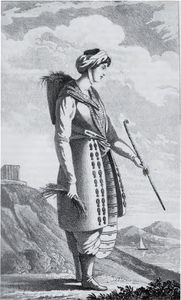
2. Greece before the Revolution.
An Albanian woman living near the ruins of the ancient temple at Sounion, in Attica.
The revolt quickly lost momentum. Hypsilantes proved unable to control his motley army or even to persuade it to pursue a common strategy, and his troops were responsible for widespread pillage and murder including the gratuitous massacre of the Turkish merchant colony at Galatz. He decided to march to Bucharest but made no sensible plans to prepare to meet the Turkish army. After two months his revolt had made no progress. He had nowhere to retreat to and all he could do was await the Turkish counterattack in the forlorn hope that something would turn up.
The Ottoman Government in Constantinople, faced with violent revolutions in different parts of the Empire, decided to answer terror with terror. A policy of exterminating all Greeks in the Ottoman Empire seems to have been seriously considered, as it had been at earlier periods of Turkish history, but when the Sultan remembered how great a proportion of the imperial revenues was derived from his Christian subjects, he decided upon a more selective policy.
The Patriarch of Constantinople occupied a special place in the administration of the Empire. He was regarded as their leader by all the Greek Orthodox community, but at the same time he was a high Ottoman official responsible to the Government for a wide range of administrative, legal, and educational subjects. He held his office on the appointment of the Government and was, according to Turkish practice, regarded as responsible for the good conduct of the Greeks. On Easter Sunday, the reigning Patriarch, Gregorios, was formally accused of being implicated in the Greek rebellion and was summarily hanged. His body remained for three days suspended from the gate of the Patriarchate, and was then dragged through the streets and thrown into the sea. On the same day three bishops and a dozen other Greeks who had held high office in the Ottoman Government service were publicly executed in various parts of the city. The Patriarch had played no active part in the preparations for the Revolution, although it could not be denied that he had known what was planned, and before his death he had pronounced a solemn excommunication on the rebels and called upon them to return to their allegiance. His successor repeated the excommunication. The Greek revolutionaries, therefore, although they regarded the Patriarch as a martyr, were in rebellion not only against the Turks but against their own ecclesiastical authorities.
During the few weeks after the hanging of Gregorios, the Ottoman Government sought out prominent Greeks from all over the capital, men in the Government service, men with high positions in the Church, men of noble family and men who were simply rich, and put them to death by hanging or beheading. Hardly a day passed without a public display. On 15 June five archbishops and three bishops were executed. In early July more than seventy Greeks shared their fate. In other cities the same policy was pursued. On 3 May at Adrianople an ex-patriarch, nine other priests, and twenty merchants were hanged outside the Metropolitan Church. Greeks of lesser importance were sent into exile to the remote provinces. Some were put to death on their arrival at their places of banishment, others were imprisoned. On one day four hundred and fifty Greek shopkeepers and tradesmen were rounded up in Constantinople and sent to work in the mines.
These were all deliberate official acts of the Ottoman Government decided upon by Sultan Mahmoud himself. The object was entirely political. The men concerned were put to death because they were Greeks and no serious attempt was made to show that they had been personally implicated in the revolts, although the opportunity was taken of purging the church of possible dissidents. Since the Greeks as a community had revolted, the Greeks as a community had to be punished, even if the individuals who had revolted and the individuals who were punished lived hundreds of miles apart and knew next to nothing of one another.
The official executions were only a prelude. When the first news of the revolt reached Constantinople, the Islamic religious authorities, with the acquiescence of the Government, called on all good Moslems to avenge the murders committed by the Christians. For three weeks anarchy was permitted in the city and in the villages nearby. Bands of Turks led by religious fanatics and insubordinate janissaries roamed the streets killing, plundering, and burning. The Greek quarter was abandoned to the mob. Hundreds of Greeks were slaughtered, churches and houses were broken into and looted, and fires raged uncontrolled. The streets were strewn with rotting corpses.
At Smyrna there was a still greater massacre. The city mob was joined by hordes of Turks from the interior who had banded together with the declared intention of marching to the scene of the revolt. Turkish troops stationed outside disobeyed their officers and entered the city. For a while the authorities attempted to keep control and, apart from sporadic murders and riots, some form of order was maintained. But when news arrived of the sinking of a Turkish ship, the situation got out of hand. The local Turkish magistrates were called on by the mob to sign a document authorizing the extermination of the Christians. When they refused they were themselves murdered. Three thousand armed Turks entered the Greek quarter and sated their lust for revenge on the defenceless populace.
Similar scenes occurred throughout the Ottoman Empire wherever there were Greek minorities. At Cos some hundreds of Greeks were killed, at Rhodes some thousands. In Cyprus, which had enjoyed good community relations, there were at first only isolated murders, until the Pashas of Aleppo and Acre were ordered to send troops to secure the island. When their Syrian troops landed, law and order broke down. Nicosia and Famagusta were sacked and the island was given over to killing and pillage. The local Turks joined in. The archbishop, five bishops, and thirty-six other priests were put to death.
Kydonies, on the coast of Asia Minor, was a thriving Greek city of thirty thousand inhabitants, established forty years earlier by colonists from the islands. The local pasha stationed a corps of his troops in the neighbourhood with strict orders to prevent any Turkish mobs from entering, but the news of the hanging of the Patriarch convinced the fanatics that the Government was in favour of an extermination of the Christians. The Kydonians, fearing that the pasha’s troops would not be able to give protection, appealed desperately for help to the Greek fleet and four or five thousand were taken off by Hydriote ships, but the appearance of the ships provoked the Turks beyond endurance. The town was burned to the ground and thousands of Greeks were massacred. The survivors, mostly women and children, were rounded up and sent to the slave markets at Smyrna and Constantinople.
Besides terrorizing the Christian minorities into obedience in this way, the Ottoman Government also set in hand military measures to deal with the Revolution itself. The various military governors gathered their forces to restore the Ottoman sovereignty in the revolted provinces.
Alexander Hypsilantes, isolated and exposed in the Danubian Provinces, never had much prospect of success. His army, which had been disunited and undisciplined from the start, became a rabble, splitting up into separate bands and ravaging the country. When the arrival of a Turkish army became imminent, many of his followers melted away with their plunder. Some crossed to Austria, where they were handed over to the Turks, others found a temporary refuge in Russia. Hypsilantes himself tried desperately to maintain his authority and even arranged the assassination of one of his local allies, but this merely caused others to take their troops back over to the Turkish side. Almost the only force which put up a sustained resistance to the advancing Turkish army was a small band of expatriate Greeks, mostly students from European universities without military experience. At Dragashan they were attacked by a superior force of Turkish cavalry, their squares were broken, and they suffered heavy losses. The survivors staggered back to the Pruth and on 29 June made a last stand behind trenches within sight of a Russian army on the other side of the river. Only a small remnant escaped across the river to Russia. Alexander Hypsilantes himself had left before the battle. He fled to Austria where the authorities, rather than extradite him to Russia to be shot as a deserter, put him in prison. In less than four months the ill-judged and badly executed revolt in the Danubian Provinces came to an end, and they played no further part in the Greek War of Independence.
In the northern parts of Greece, too, the Turks had little difficulty in reimposing their authority. In the north-west there was already a large army which had been engaged for several years in trying to put down a rebellion by Ali Pasha of Ioannina. By rapidly deploying troops in strategic places, the Turks were able to isolate most of Epirus from the rest of Greece and, by subsidies, managed to retain the loyalty of much of the Albanian population. The revolutionaries made several forays from the south, but in spite of some apparent success against detachments of the army, they made little progress in spreading the revolt. Gradually the Turks regained control over the whole region.
In the north-east the Turkish general, adopting the traditional strategy, led an army into the area of Mount Pelion, reoccupied without difficulty the towns that had joined the revolt, and burned them down. All the men that he could capture were put to death, and the women and children were carried off to the slave market at Salonika. Except for one isolated town which hung on until 1823, all of Thessaly reverted to Ottoman authority. In Macedonia the revolutionaries had murdered the Turks as they did elsewhere, but their numerical superiority was not so great and they were not so thorough. The Turkish troops succeeded in maintaining their authority in the streets of Salonika even when the revolutionaries appeared outside, and soon they had reconquered the whole area except for a few isolated pockets which were to be crushed before the winter, with the usual massacres of the men and removal of the women to the slave market. Only the revolutionaries of Mount Athos escaped by paying an indemnity at the time of their surrender.
When the Ottoman fleet returned to Constantinople after its first cruise against the rebels, a victory celebration was arranged for the delectation and terrorization of the populace. As each ship entered harbour, the prisoners herded on the decks with ropes round their necks were dropped from various parts of the rigging until all the bowsprits and yard-arms were crowded with men struggling in the agonies of death. It was said that most of these unfortunate Greeks were not rebels but seamen serving in the Ottoman fleet.
All these events occurred during the first months of the Revolution, most of them in the first few weeks. It is impossible to give a reliable estimate of the numbers who lost their lives. Even an order of magnitude is difficult to establish. Contemporary accounts are sparse and eye-witnesses notoriously untrustworthy in such confused situations. Many of those who apparently escaped the first massacres were soon involved in other outbreaks or died of starvation, exposure, or disease shortly afterwards. Others who survived as slaves were soon killed off as their usefulness diminished. It seems certain, however, that during the terrible summer of 1821 several tens of thousands of Turks were killed and several tens of thousands of Greeks. Only a tiny minority on either side were killed in battle in the usual sense of the term. In Southern Greece none of the settled Turkish or Moslem Albanian Communities survived, and in Constantinople and Asia Minor the Greek population was terrorized into such a state of submission that during the whole course of the war and for years later they were never again a threat to the Turkish power.
From many points of view the Greek population of the Ottoman Empire was better off in the years before the Revolution than it had ever been. As far as the Greeks of wealth and education were concerned, opportunities for advancement in the Ottoman service were steadily improving. A growing number of positions in the Government service were reserved for them, some on a hereditary basis, and in the two Danubian Provinces the Romanians and Slavs were ruled exclusively by Greeks. A large Greek mercantile class had grown up and most of the foreign trade and shipping was in the hands of Greeks. Thriving colonies of Greeks, often very rich, were establishing themselves in the cities and ports of Western Europe and Southern Russia. In the regions of the Empire where the Greeks were in the majority they had their own municipal institutions largely independent of Turkish interference. The Greek Church, with its headquarters at Constantinople, enjoyed wide-ranging privileges and was an integral part of the administration of the Empire. Even the Greek peasants could console themselves with the thought that they were exempt from some of the burdens, such as military service, which caused great suffering to the Moslem inhabitants of the Empire. They were considered by observers before the Revolution to be in a more fortunate position than the Catholic Irish.
In many areas of Greece, Greeks and Turks lived together on reasonably amicable terms. In some parts of the Peloponnese the population was almost entirely Greek, in others almost entirely Turkish. The Turkish garrisons were small and had been so little needed for internal security duties that they had long since neglected their training. The fortresses had been allowed to fall into disrepair and in some places the only armament was guns and powder left over from the Venetian occupation. Some of the Turks had been so long settled among the Greeks that they no longer could speak Turkish. When the history of the Greek Revolution came to be written, the Greeks in their search for justification tended to recall many of the institutions of Turkish tyranny—such as forcible abduction of children to serve as janissaries—that had fallen into disuse long before the Revolution.
The Greeks had genuine and severe grievances. In the collection of taxes the Government was unjust, arbitrary, and oppressive, and the fact that the tax collectors were the local Greek leaders did not protect the Turkish Government from the blame. The taxes usually fell on the poorest classes, and Turkish governors regarded personal enrichment as a normal perquisite of their position. Much of the best land was owned by Turks and they were to a large extent shielded from this exploitation. In addition the Greeks were subjected to a range of humiliating regulations and restrictions deliberately designed to emphasize their inferior status: these could only be avoided by a change of religion.
The Government was unable to maintain effective law and order. Bands of robbers infested the mountains and often descended into the plains, causing great misery to the settled population both Greek and Turk. To try to control these robbers and to keep open the lines of communication, the Turkish authorities had for centuries permitted local leaders to maintain troops, but they were often as rapacious as the robbers themselves. The distinction between the klephts, the robbers, and the armatoli, the licensed armed Greeks, was hardly noticed by the Greeks of the plains, although later history was to build up an image of the klephts as patriots and freedom fighters.
In the eyes of the majority of Greeks in the Ottoman Empire, it was primarily their religion that distinguished them from the Turks, Arabs, Armenians, Jews, and others who made up the population of the Empire. All their feelings of being a community centred on the Orthodox Church with its Patriarch at Constantinople, and they felt themselves as alien to the Roman Catholic Greeks who inhabited some of the islands as to the Moslems. Their tradition led back to the great days when a Greek-speaking Roman Emperor sat on the throne of a Christian Empire at Constantinople and the Orthodox Church and the Patriarchate had an unbroken succession which had been little affected by the Turkish conquest. The Greek language which they spoke was known as ‘Romaic’ from the time when they had been citizens of the Eastern Roman Empire. They called their children after the saints of the Orthodox Church, Georgios, Demetrios, Spyridon.
Most Greeks in the Ottoman Empire had no comprehension of that complex of ideas relating to territorial boundaries and cultural and linguistic uniformity which makes up the European concept of a nation state. The concept was equally strange to the Turks who for long afterwards were to regard the name of Turk as a term of abuse. The animosity between the various communities arose predominantly from their religious differences. Within the Ottoman system, advancement was open to an able man regardless of origin, provided only that he was a Moslem, and numerous Greeks had reached positions of great power by embracing Islam, Several generals on the Turkish side during the Greek Revolution were Moslem Greeks. The Albanians, some of whom were Christian and some Moslem, were torn by this dilemma, and when the need for decision became inescapable, they divided by religion and not by ethnicity. The Roman Catholic Greeks, who lived in the islands which had been under Venetian or Genoese rule, regarded themselves as a separate community. The Albanians of Hydra and Spetsae, many of whom could not even speak Greek, regarded themselves as Greek because their allegiance was to the Orthodox Church.
For centuries the leaders of the Greek and Moslem religions had preached hatred of one another. For an Infidel of the opposed religion no contempt was too great, no feelings of humanity need intrude. If a man was hated by God, then mere human beings had a clear duty to do God’s work for him. The simple Greek peasants who remorselessly killed their Turkish neighbours saw the Revolution as a war of religious extermination and, for the most part, the bishops and priests who led them shared this view. The first Greek revolutionary flags portrayed a cross over an upturned crescent or a cross over a severed Turkish head. Turkish boys who were not put to death were forcibly baptized, just as Greek boys captured by the Turks were forcibly circumcised. Under the banners of the Cross and the Crescent murder could be a religious duty.
The peasants of Greece were, however, merely the instrument of the Greek Revolution. The cause lay in a complex of ideas mostly imported from the West, which towards the end of the eighteenth century began to make their influence felt in Greece. During the late eighteenth century the colonies of Greeks in the cities of Italy, France, Austria, and Russia, grew and prospered. At first they were mainly communities of merchants interested principally in making money but, by the time of Napoleon, they had leisure for other activities. While remaining determinedly Greek, they became increasingly integrated into the countries where they had settled; their sons attended European universities, served in European armies, and absorbed the European political and intellectual ideas of the time. It was these overseas Greeks who first conceived a Greek Revolution as a nationalist movement on the European model. Their ideas were more complex than the simple wish to vent religious hatred which inspired the Greeks in Greece, and it was they who provided the initiative and organization which launched the Revolution.
Sometime around 1814 a few prominent Greeks living mainly in Russia formed a secret society, the ‘Friendly Society’, with the aim of promoting a revolution in the Ottoman Empire. Members were given the responsibility of finding new recruits who were admitted into the Society with awesome ceremonies of initiation and oaths of secrecy. The new members were told almost nothing of the nature of the controlling organization. Soon messengers were being sent over Europe to all communities where Greeks lived, and the leaders of the Greeks in the Ottoman Empire were initiated in increasing numbers—bishops, local landowners, municipal officials, ship-owners, and robber chieftains. The conspiracy became widespread and indiscriminate, and few of its members had any clear idea of what was being planned. The ordinary Greeks, who did not understand the complex and alien political concepts of nationality put about by the educated Greeks, simply assumed that the overseas Greeks like themselves were interested in an extermination of their religious adversaries. If hardly anyone had much idea of the real nature of the Friendly Society, this merely served to make it appear more widespread and more powerful than it really was.
Meanwhile another force was moving in the opposite direction. Sultan Mahmoud, who in 1808 had taken over the government of the Empire, was a patient, determined, and ruthless ruler, who seemed to be reversing the long decline of the power of the Ottoman Empire. In 1820 Mahmoud decided that he was strong enough to bring back to obedience one of the last of the powerful independent pashas, Ali Pasha of Ioannina, who had ruled much of Albania and north-west Greece for nearly twenty years. In February 1820 Ali was ordered to Constantinople in person to give an account for certain crimes of which he had been accused. When he refused, he was declared a rebel and an army was mustered to restore the Ottoman authority. By midsummer, as a result of swift decisive action by the imperial authorities, Ali was surrounded by hostile forces and it was clear that a long struggle would be undertaken to subdue him.
It was Ali’s rebellion in 1820 that precipitated the Greek Revolution. The conspirators overseas calculated that, if the Turks succeeded in putting down Ali Pasha, Turkish power throughout Greece would be immeasurably strengthened and a later Greek Revolution would have much less chance of success. If, however, they struck while Ali was still able to fight, then the Turkish forces would be divided and weakened. The Turks, for their part, feared that Ali might try to extend the area of rebellion. They noticed his overtures to the Greeks, promising political benefits if they would help him against the Turks, and found themselves obliged to make counter-offers in an attempt to maintain their loyalty. All over the Peninsula the Greeks, especially those who were permitted to have arms, found themselves being drawn into a position of having to declare either for Ali or for the Turkish Government.
The overseas conspirators decided suddenly to intensify their preparations. Messengers were sent all over Greece and thousands more Greeks were enrolled in the conspiracy. The building up of a treasury, the collection of arms, and the manufacture of gunpowder were speeded up. The klephts organized themselves to be ready for violence, and some of their leaders returned secretly from exile. The ship-owners of the islands recalled their vessels to Greek harbours. A general air of expectancy built up all through 1820.
The sudden increase in tension was not lost on the Turks. They knew a good deal about the conspiracy, and rumours that a revolution was imminent were constantly being passed to them. They decided to take precautions. Orders were issued to repair some of the fortresses of the Peloponnese and, for the first time for many years, a start was actually made in putting these orders into effect.
In the Peloponnese, therefore, events moved inexorably towards the classic prelude to civil war. Both communities could see that the other was making preparations in case of trouble, and every act which each side took was a provocation to the other. It was increasingly obvious that whichever side dared to strike the first blow would give itself an overwhelming advantage. Both parties knew that the Turks did not have enough military resources in the area to hold down an armed population by normal means and that the usual Turkish policy in such circumstances was to try to head off trouble by making an example here and there. The Greeks were aware that, in the event of an unsuccessful revolt, the Turks were unlikely to distinguish between the innocent and the guilty when it came to restoring their authority. The overseas conspirators had no real appreciation of the situation in the Peloponnese. It was part of their plan that the revolution should break out simultaneously in all parts of the Ottoman Empire, but they unwisely decided to make their main effort in the Danubian Provinces.
The revolution in the Peloponnese broke out even before Alexander Hypsilantes raised his standard on the Danube. In February 1821 the chief Turkish officials met at Tripolitsa to consider how to contain the revolutionary fever which was everywhere in the air. They had basically two choices, either to do nothing provocative in the hope that the tension would die down or to take some strong action in the hope of forestalling trouble in advance. They chose the latter. Orders were issued for the Greek population to hand in their arms to the authorities, and the various local Greek leaders were asked to come in person to Tripolitsa.
The Turkish action, instead of quietening the situation, precipitated the tragedy it was intended to prevent. The Greek leaders were put in a dilemma. They were obliged to choose either revolution or submission; no middle course remained open. Even at this stage many would undoubtedly have preferred submission but almost at once the decision was taken out of their hands. The Greeks who were party to the conspiracy proclaimed a revolution and began to murder the Turkish population. Once the first blood was shed there was no going back. The revolutionaries believed that only by ruthlessness could they preserve their safety In the long run; once the murdering had begun, half measures would be fatal. Suddenly the pent-up hatreds, which had been deliberately intensified during the period of rising tension, were let loose. The bishops and priests exhorted their parishioners to exterminate the infidel Moslems. The klephts and armatoli came down from the mountains and ravaged the Turkish settlements. Control soon passed out of the hands of the leaders and the whole country was overrun by bands of armed men killing and plundering. The Turks of Greece paid the penalty for centuries of wrongs, real and imagined, and for their inherited religious beliefs. But the savage passion for revenge soon degenerated into a frenzied delight in killing and horror for their own sakes. The Turkish counter-terror which began with the hanging of the Patriarch at Constantinople on Easter day, started before the Ottoman Government realized the full extent of what was happening in the Peloponnese, but soon it was in full swing. Atrocity was answered by atrocity as Greeks and Turks struck mercilessly at their defenceless neighbours. The orgy of genocide exhausted itself in the Peloponnese only when there were no more Turks to kill.
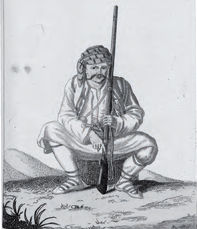
a. An Albanian soldier.
The Ottoman garrison employed Albanians who had lived there for so long nobody knew when they had first arrived.
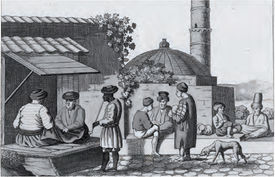
b. The bazaar at Larissa in Thessaly.
The artist emphasises its multi-ethnic character that is also descibed in the book.
3. Greece before the Revolution.
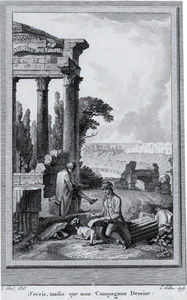
4. Philhellenism before Byron.
‘I wrote while my companion drew’. French travellers recording and contemplating the ruins of ancient civilization.



